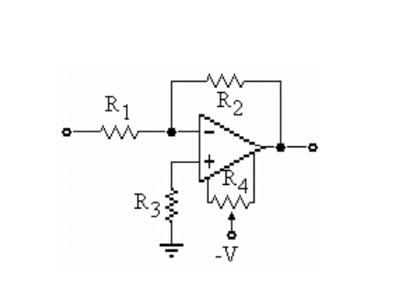A) differential and extremely high.
B) differential and common- mode.
C) differential and common- loop.
D) closed- loop and common- mode.
Correct Answer

verified
Correct Answer
verified
Multiple Choice
There can be no current to ground through
A) a virtual ground.
B) an ordinary ground.
C) a mechanical ground.
D) an ac ground.
Correct Answer

verified
A
Correct Answer
verified
Multiple Choice
The loop gain AOLB
A) may not equal 1.
B) is usually much smaller than 1.
C) is between 0 and 1.
D) is usually much greater than 1.
Correct Answer

verified
Correct Answer
verified
Multiple Choice
The voltage gain of an op- amp is unity at the
A) unity- gain frequency.
B) cutoff frequency.
C) generator frequency.
D) power bandwidth.
Correct Answer

verified
A
Correct Answer
verified
Multiple Choice
The closed- loop input impedance in a noninverting amplifier is
A) ideally zero.
B) sometimes less than the open- loop input impedance.
C) equal to the open- loop input impedance.
D) much greater than the open- loop input impedance.
Correct Answer

verified
Correct Answer
verified
Multiple Choice
In an op- amp, the CMRR is limited mostly by the
A) gain- bandwidth product.
B) the common- mode gain of the op- amp.
C) tolerance of the resistors.
D) supply voltages.
Correct Answer

verified
Correct Answer
verified
Multiple Choice
 -Refer to the figure above. This op- amp has a slew rate of 1.33 V/µs. How long would it take the output voltage to change from - 12 V to +12 V?
-Refer to the figure above. This op- amp has a slew rate of 1.33 V/µs. How long would it take the output voltage to change from - 12 V to +12 V?
A) 36 µs
B) 18 µs
C) 48 µs
D) 16 µs
Correct Answer

verified
Correct Answer
verified
Multiple Choice
 -Refer to the figure above. Which components are used to set input impedance and voltage gain?
-Refer to the figure above. Which components are used to set input impedance and voltage gain?
A) R4
B) R3
C) R3 and R4
D) R1 and R2
Correct Answer

verified
Correct Answer
verified
Multiple Choice
 -Refer to the figure above. If these three circuits were connected as a multiple- stage amplifier, the total voltage gain would be
-Refer to the figure above. If these three circuits were connected as a multiple- stage amplifier, the total voltage gain would be
A) 10.
B) 21.
C) 210.
D) 1.
Correct Answer

verified
Correct Answer
verified
Multiple Choice
What is the value of compensating resistor needed for a noninverting op- amp circuit using 10 k▲ resistors for both RI and RF?
A) 100 k▲
B) 5 k▲
C) 20 k▲
D) 10 k▲
Correct Answer

verified
B
Correct Answer
verified
Multiple Choice
 -Refer to the figure above. Which components are used for bias current compensation?
-Refer to the figure above. Which components are used for bias current compensation?
A) R2
B) R3
C) R4
D) R1 and R2
Correct Answer

verified
Correct Answer
verified
Multiple Choice
The ideal op- amp has
A) infinite input impedance and zero output impedance.
B) infinite output impedance and zero input impedance.
C) infinite voltage gain and infinite bandwidth.
D) Both A and C.
Correct Answer

verified
Correct Answer
verified
Multiple Choice
The closed- loop voltage gain of an inverting amplifier equals
A) the input resistance.
B) the ratio of the input resistance to the feedback resistance.
C) the open- loop voltage gain.
D) the feedback resistance divided by the input resistance.
Correct Answer

verified
Correct Answer
verified
Multiple Choice
The feedback fraction "B"
A) may not equal 1.
B) is usually greater than 1.
C) may equal 1.
D) is always less than 1.
Correct Answer

verified
Correct Answer
verified
Multiple Choice
 -Refer to the figure above. Which circuit is a voltage follower?
-Refer to the figure above. Which circuit is a voltage follower?
A) a)
B) b)
C) c)
D) None of the above.
Correct Answer

verified
Correct Answer
verified
Multiple Choice
The op- amp can amplify
A) dc signals only.
B) ac signals only.
C) both ac and dc signals.
D) neither ac nor dc signals.
Correct Answer

verified
Correct Answer
verified
Multiple Choice
A voltage follower amplifier comes to you for service. With a sine wave input of 1 V, the output is squared off at approximately 30 V peak- to- peak. The most likely problem is
A) the input is shorted to ground.
B) open feedback loop.
C) the output is shorted to ground.
D) no dc supply voltage.
Correct Answer

verified
Correct Answer
verified
Multiple Choice
 -Refer to c) in the figure above. If an amplifier with an input impedance of 12 k▲ and the same voltage gain is needed, the new value of R1 would be______ and the new value of Rf would be _________.
-Refer to c) in the figure above. If an amplifier with an input impedance of 12 k▲ and the same voltage gain is needed, the new value of R1 would be______ and the new value of Rf would be _________.
A) 12 k▲, 108 k▲
B) 12 k▲, 120 k▲
C) 13.3 k▲, 120 k▲
D) 10 k▲, 100 k▲
Correct Answer

verified
Correct Answer
verified
Multiple Choice
 -Refer to the figure above. Which circuit has a voltage gain of 20?
-Refer to the figure above. Which circuit has a voltage gain of 20?
A) a)
B) b)
C) c)
D) None of the above.
Correct Answer

verified
Correct Answer
verified
Multiple Choice
If an op- amp were perfect, the CMRR would
A) be zero.
B) be very small.
C) approach infinity.
D) be less than one.
Correct Answer

verified
Correct Answer
verified
Showing 1 - 20 of 44
Related Exams